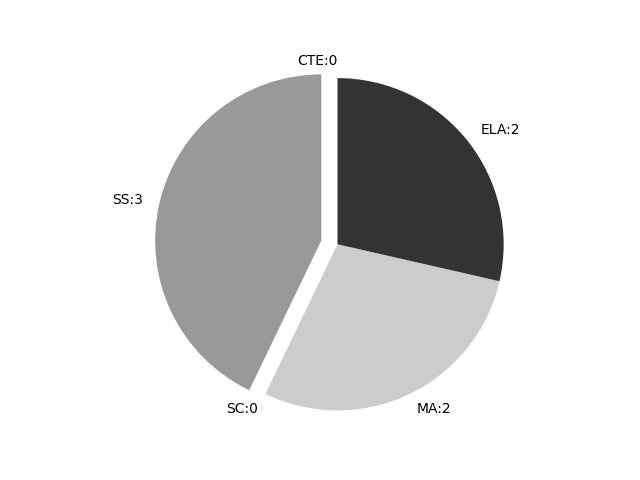GIStandards
https://trbaker.github.io/GIStandards/
A machine analysis of geospatial language in US K-12 state curriculum standards
New Mexico
Report date: 2021-07-08
The frequency of all keywords found in this state's standards: 7
Comparable state score: 0.273 (median: .303, SD: .324)
The frequency above is the sum of all keywords found in all of this state's four core academic standards and the state's CTE/career standards. This total count is broken down by keyword and discipline area below.
On this site, 'comparable scores' are calculated as: keywords found divided by total words in the standards document(s) - multiplied by 100,000. The comparable scores attempt to normalize data, accounting for very different sizes of curriculum guidance documentation.
Frequencies by keyword or phrase:Frequencies by discipline area: - SS: 3
(Comp: 0.763) - SC: 0
(Comp: 0.0) - MA: 2
(Comp: 0.216) - ELA: 2
(Comp: 0.347) - CTE: 0
(Comp: None)
Support files: Examples of keyword use by discipline area (and document): - ELA
- ADA_CC_MathStandards.pdf, page:1, position:565
greater focus and coherenceMathematics experiences in early childhood settings should concentrate on(1) number (which includes whole number, operations, and relations) and (2) geometry, spatial relations, and measurement, with more mathema - ADA_CC_MathStandards.pdf, page:8, position:309
combined sets, or counting the number of objects that remain in a set after some are taken away.Students describe their physical world using geometric ideas (e.g., shape, orientation, spatial relations) and vocabulary. They identify, nam
- MA
- ADA_CC_MathStandards.pdf, page:2, position:227
greater focus and coherenceMathematics experiences in early childhood settings should concentrate on (1)number (which includes whole number, operations, and relations) and (2)geometry, spatial relations, and measurement, with more mathematics - ADA_CC_MathStandards.pdf, page:8, position:1334
objects in combined sets, or counting the number of objectsthat remain in a set after some are taken away.(2)Students describe their physical world using geometric ideas (e.g.,shape, orientation, spatial relations) and vocabulary. They identify, name,a
- SS
- SocialStudiesStandards_9-12.pdf, page:3, position:2538
Performance Standards 1. Understand how to use the skills of historical analysis to apply to current social, political, geographic and economic issues; 2. Apply chronological and spatial thinking to understand the importance of events; - SocialStudiesStandards_9-12.pdf, page:4, position:703
Standards 1. Evaluate and select appropriate geographic representations to analyze and explain natural and man-made issues and problems; 2. Understand the vocabulary and concepts of spatial interaction, including an analysis of population - SocialStudiesStandards_5-8.pdf, page:4, position:1633
employ fundamental geographic vocabulary (e.g., latitude, longitude, interdependence, accessibility, connections); 6. demonstrate a relational understanding of time zones; 7. use spatial organization to communicate information; and 8.
On this site, 'comparable scores' are calculated as: keywords found divided by total words in the standards document(s) - multiplied by 100,000. The comparable scores attempt to normalize data, accounting for very different sizes of curriculum guidance documentation.
(Comp: 0.763)
(Comp: 0.0)
(Comp: 0.216)
(Comp: 0.347)
(Comp: None)
- ADA_CC_MathStandards.pdf, page:1, position:565
greater focus and coherenceMathematics experiences in early childhood settings should concentrate on(1) number (which includes whole number, operations, and relations) and (2) geometry, spatial relations, and measurement, with more mathema - ADA_CC_MathStandards.pdf, page:8, position:309
combined sets, or counting the number of objects that remain in a set after some are taken away.Students describe their physical world using geometric ideas (e.g., shape, orientation, spatial relations) and vocabulary. They identify, nam
- ADA_CC_MathStandards.pdf, page:2, position:227
greater focus and coherenceMathematics experiences in early childhood settings should concentrate on (1)number (which includes whole number, operations, and relations) and (2)geometry, spatial relations, and measurement, with more mathematics - ADA_CC_MathStandards.pdf, page:8, position:1334
objects in combined sets, or counting the number of objectsthat remain in a set after some are taken away.(2)Students describe their physical world using geometric ideas (e.g.,shape, orientation, spatial relations) and vocabulary. They identify, name,a
- SocialStudiesStandards_9-12.pdf, page:3, position:2538
Performance Standards 1. Understand how to use the skills of historical analysis to apply to current social, political, geographic and economic issues; 2. Apply chronological and spatial thinking to understand the importance of events; - SocialStudiesStandards_9-12.pdf, page:4, position:703
Standards 1. Evaluate and select appropriate geographic representations to analyze and explain natural and man-made issues and problems; 2. Understand the vocabulary and concepts of spatial interaction, including an analysis of population - SocialStudiesStandards_5-8.pdf, page:4, position:1633
employ fundamental geographic vocabulary (e.g., latitude, longitude, interdependence, accessibility, connections); 6. demonstrate a relational understanding of time zones; 7. use spatial organization to communicate information; and 8.
